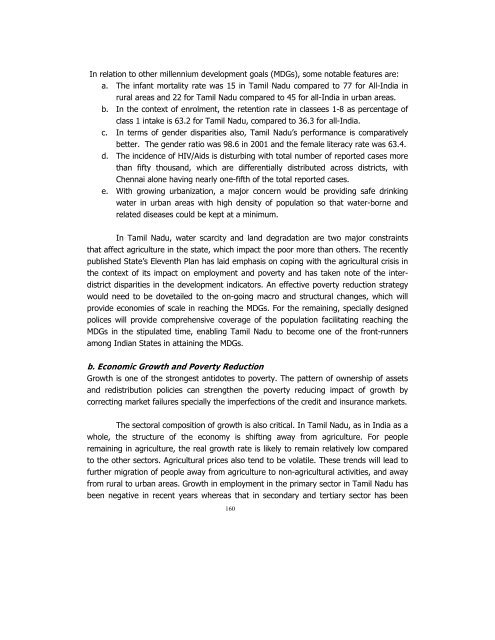POVERTY REDUCTION STRATEGY TN
Create successful ePaper yourself
Turn your PDF publications into a flip-book with our unique Google optimized e-Paper software.
In relation to other millennium development goals (MDGs), some notable features are:<br />
a. The infant mortality rate was 15 in Tamil Nadu compared to 77 for All-India in<br />
rural areas and 22 for Tamil Nadu compared to 45 for all-India in urban areas.<br />
b. In the context of enrolment, the retention rate in classees 1-8 as percentage of<br />
class 1 intake is 63.2 for Tamil Nadu, compared to 36.3 for all-India.<br />
c. In terms of gender disparities also, Tamil Nadu’s performance is comparatively<br />
better. The gender ratio was 98.6 in 2001 and the female literacy rate was 63.4.<br />
d. The incidence of HIV/Aids is disturbing with total number of reported cases more<br />
than fifty thousand, which are differentially distributed across districts, with<br />
Chennai alone having nearly one-fifth of the total reported cases.<br />
e. With growing urbanization, a major concern would be providing safe drinking<br />
water in urban areas with high density of population so that water-borne and<br />
related diseases could be kept at a minimum.<br />
In Tamil Nadu, water scarcity and land degradation are two major constraints<br />
that affect agriculture in the state, which impact the poor more than others. The recently<br />
published State’s Eleventh Plan has laid emphasis on coping with the agricultural crisis in<br />
the context of its impact on employment and poverty and has taken note of the interdistrict<br />
disparities in the development indicators. An effective poverty reduction strategy<br />
would need to be dovetailed to the on-going macro and structural changes, which will<br />
provide economies of scale in reaching the MDGs. For the remaining, specially designed<br />
polices will provide comprehensive coverage of the population facilitating reaching the<br />
MDGs in the stipulated time, enabling Tamil Nadu to become one of the front-runners<br />
among Indian States in attaining the MDGs.<br />
b. Economic Growth and Poverty Reduction<br />
Growth is one of the strongest antidotes to poverty. The pattern of ownership of assets<br />
and redistribution policies can strengthen the poverty reducing impact of growth by<br />
correcting market failures specially the imperfections of the credit and insurance markets.<br />
The sectoral composition of growth is also critical. In Tamil Nadu, as in India as a<br />
whole, the structure of the economy is shifting away from agriculture. For people<br />
remaining in agriculture, the real growth rate is likely to remain relatively low compared<br />
to the other sectors. Agricultural prices also tend to be volatile. These trends will lead to<br />
further migration of people away from agriculture to non-agricultural activities, and away<br />
from rural to urban areas. Growth in employment in the primary sector in Tamil Nadu has<br />
been negative in recent years whereas that in secondary and tertiary sector has been<br />
160

















